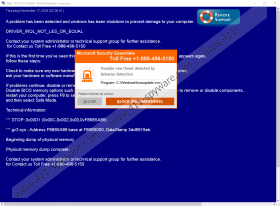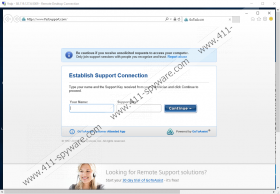Microsoft Security Essentials +1-888-496-5150 Removal Guide
The users of vulnerable Windows systems are exposed to the Microsoft Security Essentials +1-888-496-5150 scam as they download malware or if they land on a malicious page (most likely via redirect) that displays a fake notification. If you are redirected to a misleading page representing the scam, you might be able to get rid of it by closing the browser. Unfortunately, most users face the version of this scam that is controlled by a malicious file that is most likely to be downloaded silently. Unfortunately, the information presented to the victims via the fake alert is quite believable, and it is likely that many will fall for the scam. So, what happens if users follow the instructions represented via the fake message? The chances are that they will initiate communication with schemers, and that, of course, is extremely dangerous. Hopefully, you remove Microsoft Security Essentials +1-888-496-5150 scam in time, and we are here to help. Before you jump to deleting the malicious components, read this report.
Sadly, the Microsoft Security Essentials +1-888-496-5150 scam is not unique, and there is a ton of similar scams out there, including the Code 00xo4c08 Pop-up scam and 1-888-535-7102 TechScam. What all of these scams have in common is that they represent allegedly legitimate helpline numbers, which means that the misleading messages and warnings are just the first phase of the scam. The second phase starts when you call the number, and the schemers behind it start providing you with false information and urging you to follow their instructions. So, what do cyber criminals do to achieve success? When the malicious .exe file is dropped onto your computer – which you are likely to install bundled with other infections that might require removal – it immediately creates a registry for autostart. Due to this, you will be in the exact same situation every time you restart your computer, which means that you will face the same fake BSOD screen. You must not pay any attention to the information provided via this screen; however, the Microsoft Security Essentials +1-888-496-5150 alert is displayed at the same time, and that might confuse many users. Instead of deleting malware, they might decide to call the number.
The fake Microsoft Security Essentials +1-888-496-5150 alert that shows up in front of the fake BSOD screen is meant to trick you into thinking that some kind of threat was detected by Microsoft. If you look at the information behind this alert, you are asked to restart your computer. Obviously, nothing will change due to the startup modifications, and the alert will push you to call the fake helpline, which is introduced as a reliable “technical support group.” If you click the “REMOTE SUPPORT” button on the top-right corner, you will open the fastsupport.com page. This page warns that you should be cautious about requests to access your computer, which is ironic, considering that the schemers behind the +1-888-496-5150 helpline might ask you to download software that enables remote access! Obviously, this is just meant to trick you into thinking that the page is authentic and trustworthy. This page promotes the “GoToAssist Customer Attended App” software, which you should NOT install under any circumstances.
If you have granted the schemers behind the Microsoft Security Essentials +1-888-496-5150 scam access to your operating system, it is possible that your virtual security has been jeopardized already. Virtual schemers are completely unpredictable, and it is difficult to now what kind of information they might provide you with if you call the fake helpline number. If you have downloaded any unfamiliar software, you must remove it immediately. Right now, we want to show you how to delete Microsoft Security Essentials +1-888-496-5150 components from your operating system. Because the manual removal process might be complicated if you are inexperienced, we strongly suggest employing anti-malware software. Also, other threats might be active on your PC if the malicious executable was packaged with malware. Finally, anti-malware software can keep up with your virtual protection, and that is very important.
Removal Guide
- Tap Ctrl+Shift+Esc keys to launch Task Manager.
- Click the Process tab and kill the process named bsodm.exe.
- Now, tap Win+E to launch Windows Explorer.
- Enter %ProgramFiles(x86)% (or %ProgramFile%) into the address bar.
- Delete the file named bsodm.exe (if you cannot find this file, check the Downloads, Desktop, and Temp folders, or use an automated malware scanner to detect it).
- Finally, tap Win+R to launch RUN and then enter regedit.exe to access the Registry Editor.
- Navigate to HKEY_CURRENT_USER\Software\Microsoft\Windows NT\CurrentVersion\Winlogon.
- Delete the value named Shell if its value data points to the malicious bsodm.exe file.
Microsoft Security Essentials +1-888-496-5150 Screenshots:



